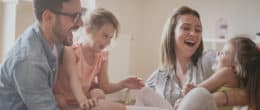How to Tell If You’re a Household Employee


File your taxes with confidence.
Your max tax refund is guaranteed.
If you work as a caregiver in someone’s home — as a babysitter, nanny, pet sitter, or nurse, perhaps — are you considered an employee?
Understanding the distinction between household employees and independent contractors is crucial for tax purposes. Let’s explore the frequently asked questions surrounding this topic to clarify your responsibilities and rights:
At a glance:
- Caretakers such as nannies and babysitters are almost always considered household employees by the IRS.
- You are considered an employee if your employer dictates how and when you work.
- Household employees are W-2 employees, and employers are responsible for withholding certain taxes from their wages.
What is a household employee?
The Internal Revenue Service (IRS) defines a household employee as someone who does household work in or around the home. You are considered a household employee if you were hired to do household work at your employer’s residence, and your employer has control over what work is done and how you do it.
You can be a household employee for full-time or part-time work, whether you were hired through an agency or independently.
For example, say you’re hired to provide childcare and cleaning services for a family three days a week. The family hired you through an agency, and they give you specific instructions about your childcare and cleaning duties, providing you with all the necessary supplies to do your job. Under these circumstances, you are their household employee.
What are the differences between an employee and a contractor in a household setting?
As an employee in a household setting, you must adhere to your employer’s instructions and operate within their home. However, a contractor functions independently, often providing services on their own terms and using their own tools. Differentiating between the two is crucial for tax purposes, as it determines tax obligations and how your income gets reported to the IRS.
When workers are not employees
Those who perform household duties in someone else’s home (as a nanny or pet sitter, perhaps) are almost always considered household employees by the IRS. Understandably, many in-home caregivers tend to be household employees because of the nature of their work. If you’re caring for someone else’s loved one in their home, they will often dictate when you are needed and what type of work you should perform.
But there are exceptions. For example, if you provide cleaning and babysitting services for multiple families in their homes, but you can choose how and when you work and bring your own supplies, you would be considered self-employed instead of a household worker. And if you provide caregiving services in your own residence, such as an in-home daycare, you would also be considered self-employed. You control the relationship in these situations, meaning you are not an employee.
What are the types of household workers?
Household workers encompass a broad spectrum of roles, from full-time nannies nurturing children to occasional cleaners maintaining a home’s tidiness. Here are some typical examples of household employees:
- Babysitters and nannies
- Caretakers
- Cleaners
- Housekeepers and maids
- Domestic workers (anyone who performs work in or for a private household)
- Drivers
- Health aides and private nurses
- Yard workers and gardeners
The following are examples of people who would NOT be considered household employees:
- Tutors
- Private secretaries
- Librarians
- Independent contractors (plumbers, carpenters, etc.)
Though the above examples may work in someone’s home, they aren’t providing services of a household nature. Therefore, the IRS doesn’t consider them household employees.
Are household employees 1099 or W-2?
Household employees are typically classified as W-2 employees. As a household employee, your employer is responsible for withholding Social Security and Medicare taxes and providing you with a W-2 form at the end of the year detailing your earnings and any taxes withheld.
You will only receive a 1099-NEC form instead of a W-2 form if you are considered self-employed.
How do household employees and household employers pay taxes?
Household employee taxes are often referred to as the nanny tax. When working as a caregiver or in-home worker, your employer must issue you a W-2 form if they paid you at least $2,600 in tax year 2023. You can use this W-2 form to file your taxes come tax time.
To properly fill out your W-2 form, you must provide your employer with your Social Security number or individual taxpayer identification number (ITIN).
What is the nanny tax?
The nanny tax refers to the federal and state taxes that must be paid when hiring a household employee.
Here’s a breakdown of who pays what:
- Your employer pays half of FICA taxes (Social Security and Medicare taxes) on your behalf and federal and state unemployment insurance.
- You, the employee, pay the other half of FICA taxes, as well as federal income tax (and state income tax, if applicable)
Your FICA taxes will be withheld from your wages as a household employee. Household employers are not required to withhold income tax from your pay; however, you can request that they do so to make things easier for you. If you go this route, you must fill out a W-4 form, so your employer knows how much income tax to withhold.
If your employer doesn’t withhold income tax, you must make estimated quarterly tax payments to pay your income tax during the year. If you choose to e-file with us, TaxAct® can help you set up automatic estimated tax payments for the coming year through Electronic Funds Withdrawal.
What is Schedule H?
Schedule H is a tax form your employer fills out to report the household employment taxes they paid. You won’t have to worry about filing Schedule H with your income tax return as a household employee.
What tax deductions can a nanny claim?
As a nanny working as a household employee, you generally can’t deduct things like unreimbursed employee expenses. For example, if you pay for your own gas to transport the children under your care while working, you would not be able to deduct the fuel expense on your federal income tax return as you would if you were self-employed.
That being said, some states, such as California, still allow you to claim unreimbursed employee expenses as a tax deduction. However, the deduction is typically based on a percentage of your adjusted gross income (AGI) and can be very limited. Be sure to double-check your state’s tax laws so you know what you can and cannot deduct when filing.
While there aren’t nanny-specific tax deductions for household employees, you may still be able to claim other valuable tax benefits. Check out this article for a list of common tax credits and tax deductions you may be able to qualify for as an employee.





